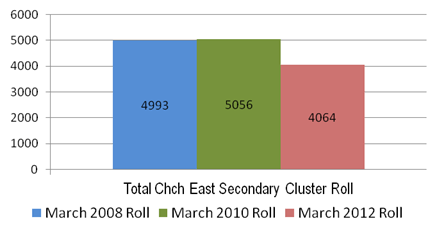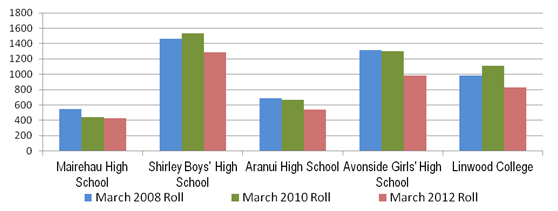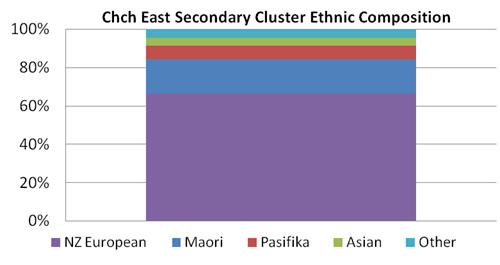Christchurch East Secondary Learning Community Cluster
Supporting information for interim decisions
Aranui High School [PDF; 41.2mb]
This learning community cluster includes five state secondary schools.
- Mairehau High School – http://www.mairehau.school.nz
- Shirley Boys’ High School – http://www.shirley.school.nz
- Aranui High School – http://www.aranui-high.school.nz
- Avonside Girls’ High School – http://www.avonside.school.nz
- Linwood College – http://www.linwoodcollege.school.nz
Governance
There are three types of schools: state, private (or registered or independent) and state integrated schools. State integrated schools are former private schools which, while now “integrated” into the state system, also provide programmes around their particular religious or learning philosophy.
State and state integrated schools, while government funded, are managed by boards of trustees.
Private schools receive only partial funding from the Government.
Day to day management of all schools is the responsibility of the principal.
The Crown is responsible for property provision for state schools to ensure students have access to their closest school. The proprietors of state integrated and private schools are responsible for their own buildings.
The East Christchurch Secondary Learning Community Cluster does not include any state integrated schools.
School boards are required to develop individual charters and annual plans and report their performance against these. You will be able to access the school charter from your school or at Find a school on the Education Counts website.
Education Review Office (ERO) reports on school and early childhood performance are publicly available.
Christchurch East secondary cluster ERO review cycle
| Mairehau High School | In progress |
| Shirley Boys’ High School | Under Review |
| Aranui High School | 1-2 years |
| Avonside Girls’ High School | 3 years |
| Linwood College | Under Review |
School roll changes
In March 2010, prior to the earthquakes, the secondary schools in this cluster provided teaching and learning to 5,056 students. While individual rolls have fluctuated, the combined secondary roll in this cluster has declined by 992 to 4,064 at March 2012.
Individual school March rolls, 2008, 2010, and 2012
The following chart shows the ethnic composition of the combined cluster school rolls by percentage of total combined roll
Education achievement
National Certificate in Education Achievement (NCEA) is the main secondary school qualification for students in years 11-13. NCEA can be gained at three levels – usually level 1 in Year 11, level 2 in Year 12, and level 3 in Year 13.
Any student who demonstrates the required skills and knowledge to the level of a particular standard, achieves NCEA credits. Each student receives a School Results Summary that presents all standards taken throughout their school years, and the results for each.
Since NCEA was introduced, more students are leaving school with qualifications.
The National priority is that 85% of all school learners will have achieved NCEA Level 2 by the time they leave school.
This table shows the numbers of school leavers in the Christchurch East Secondary Learning Community Cluster who gained NCEA level 2 before leaving school.
| Total school leavers | Māori | Pasifika | |||||||
|---|---|---|---|---|---|---|---|---|---|
| Year | Number below Level 2 | NCEA Level 2 and above number | Total number of leavers | Number below Level 2 | NCEA Level 2 and above number | Total number of leavers | Number below Level 2 | NCEA Level 2 and above number | Total number of leavers |
| 2009 | 384 | 469 | 853 | 92 | 47 | 139 | 36 | 16 | 52 |
| 2010 | 454 | 598 | 1052 | 128 | 74 | 202 | 47 | 53 | 100 |
Note: 2011/12 data is live and cannot be released.
Special Education
Special Education delivers specialist services and support to learners with special education needs across this cluster. This includes support to the schools, teachers, parents, families and whānau.
Māori and Pasifika provision
Māori-medium education programmes involve students being taught either all or some curriculum subjects in the Māori language, either in immersion (Māori language only) or bilingual (Māori and English) programmes.
There are no Māori or Pasifika bilingual units, or language programmes delivered by schools in this cluster.
English for Speakers of Other Languages (ESOL) provision
ESOL provision for refugee and new migrant learners from non-English speaking backgrounds is provided to 66 secondary learners across the schools in this cluster.
Land – State schools only
School sites sit outside the Canterbury Earthquake Recovery Authority (CERA) land classification process and will not be given any Technical Category foundation rankings, though the land in the surrounding residential area of this cluster has been classified TC2, TC3 and red zone.
Geotechnical assessments on the state school sites in this cluster indicate land issues are likely to compromise continued education provision.
Further Ministry commissioned assessments may be required at a later date, should any of these sites be further developed.
Buildings – State schools only
There are 245 teaching spaces included in the 40,525 square metres (of useable space) of teaching and learning and administration space across this cluster of schooling provision.
The teaching, learning and administrative space is incorporated into 140 actual buildings.
All of these buildings suffered damage during the earthquakes. Repairs have yet to be made to the building stock.
Condition assessments confirm over time earthquake strengthening will be required across 31 of these buildings within the cluster. There are weather tightness issues in a further 13 buildings.
Building condition information – State schools only
| Number of buildings | Number of buildings with EQ damage | Number of buildings with strengthening required | Number of buildings with weather tightness repairs required | Number of buildings with both strengthening and weather tightness repairs | |
|---|---|---|---|---|---|
| Aranui High | 30 | 30 | 4 | 2 | 0 |
| Avonside Girls High | 32 | 32 | 7 | 0 | 0 |
| Linwood-Kimihia Parents College | 1 | 1 | 0 | 0 | 0 |
| Linwood College | 35 | 35 | 10 | 2 | 1 |
| Mairehau High | 19 | 19 | 4 | 7 | 2 |
| Shirley Boys High | 23 | 23 | 6 | 2 | 1 |
| Cluster | 140 | 140 | 31 | 13 | 4 |
Based on March 2012 rolls – a minimum of 208 teaching spaces will be required for ongoing teaching and learning in this cluster, as below.
School rolls and classroom numbers – State schools only
| March 2010 roll | Classroom (no.) current (July 2012) | March 2012 roll | Estimated classrooms required at March 2012 | |
|---|---|---|---|---|
| Aranui High | 668 | 40 | 540 | 28 |
| Avonside Girls High | 1,304 | 49 | 984 | 49 |
| Linwood-Kimihia Parents College | 27 | 29 | 3 | |
| Linwood College | 1,108 | 64 | 828 | 42 |
| Mairehau High | 440 | 41 | 425 | 25 |
| Shirley Boys High | 1,536 | 63 | 1287 | 61 |
| Cluster | 5,083 | 257 | 4,093 | 208 |
The way forward
Extensive condition assessments and engineering investigations have confirmed all buildings in this cluster currently remain fit to occupy – unless already isolated.
A number of the buildings across this cluster will, however, require remediation and strengthening over the longer-term. Three are not considered cost effective to repair. This includes 28 teaching spaces.
Future planning
The earthquakes provide an opportunity, as outlined in the Education Renewal Recovery Programme [PDF; 881kb], to consider options for revitalising the greater Christchurch education network that go beyond simply replacing what was there.
Discussions with schools, communities and providers within this cluster will be key to informing decisions around the future shape of education for the East Christchurch Secondary education community.
Ways to enhance infrastructure and address existing property issues, improve education outcomes, and consider future governance will form part of these discussions.
Community engagement
The Ministry of Education will formally consult with this cluster and its community on the possible shape of future education provision.
This will include providing detailed information on the issues and options affecting the cluster for community consideration.
In line with the support signalled in the Education Renewal Recovery Programme (link to document) for improved collaboration, this will provide an opportunity to gain further suggestions around shared provision across schools and services within specific areas of interest and the wider community, as appropriate.
Boards will formally consult with their communities where closures or mergers are indicated.
Check out the engagement schedule for further details.


